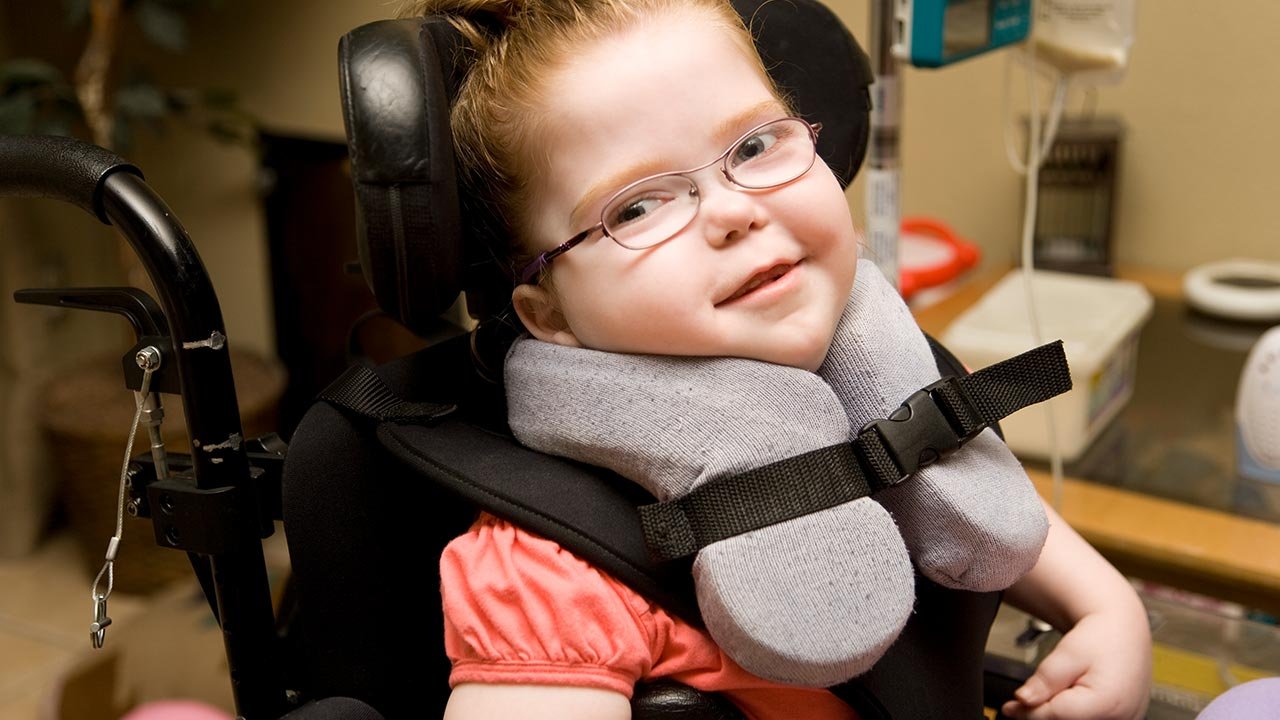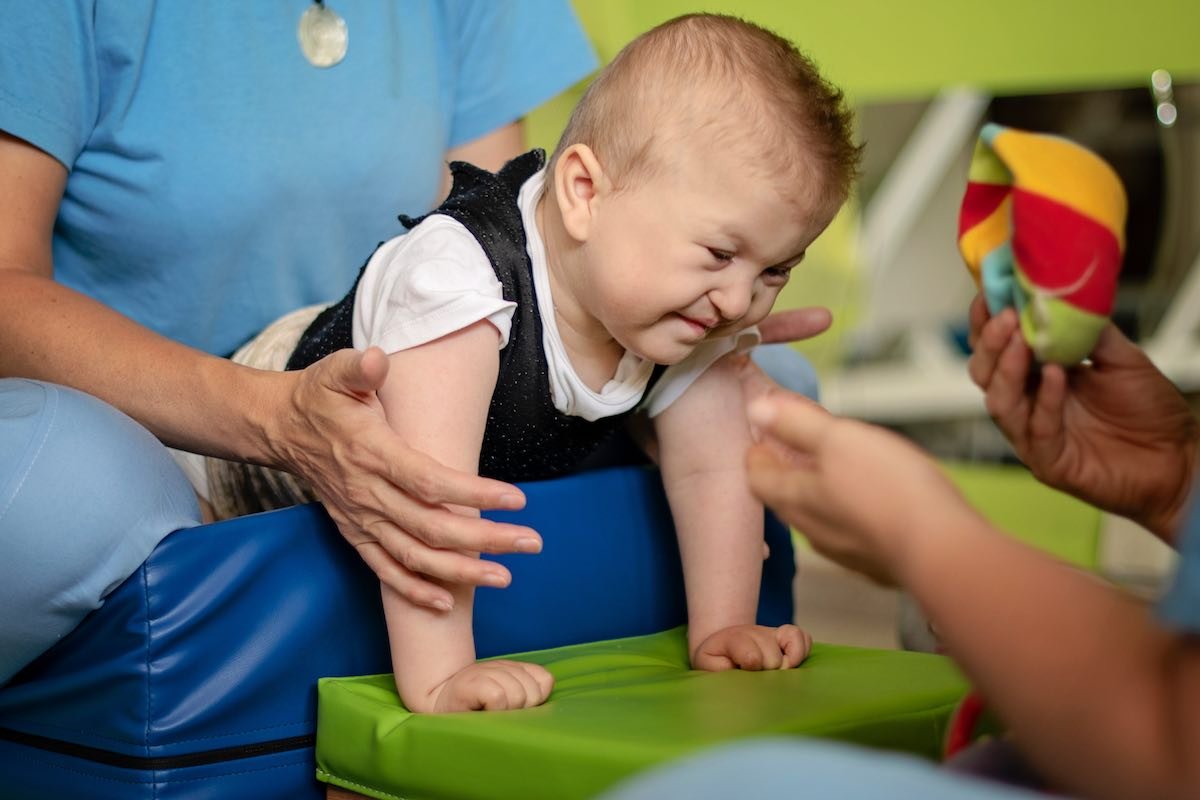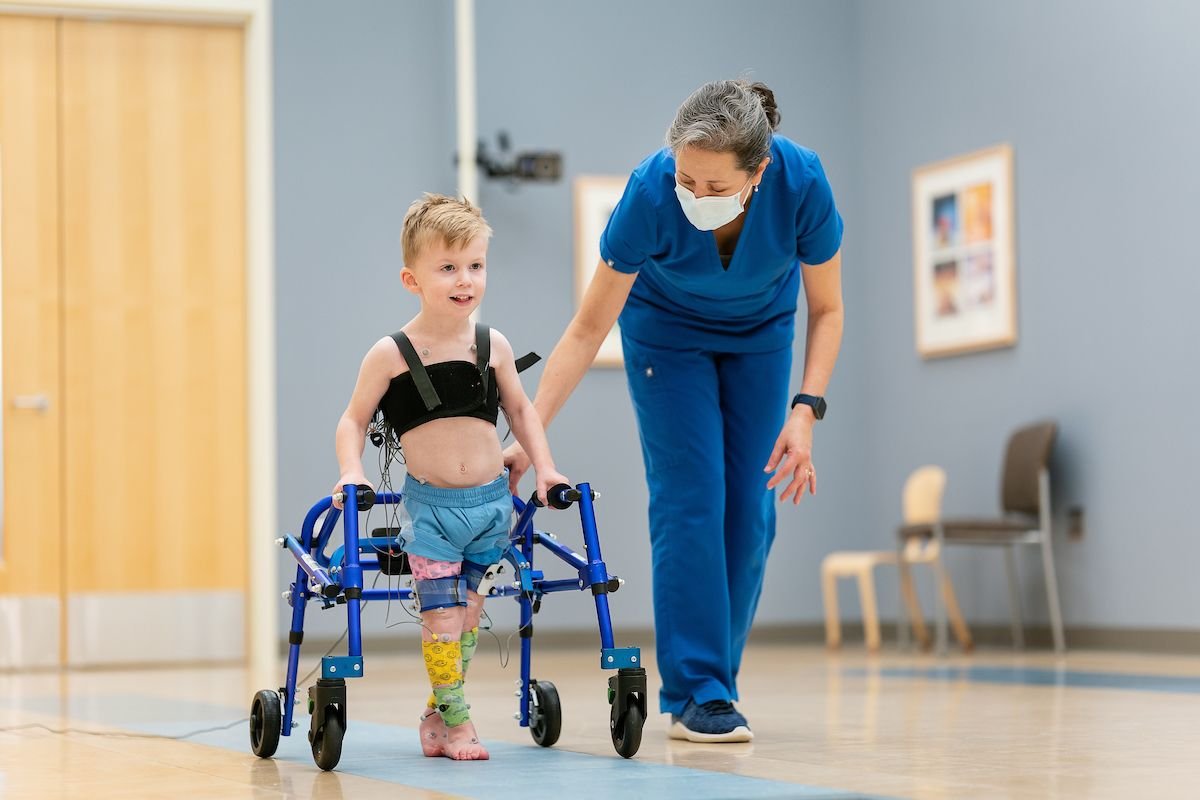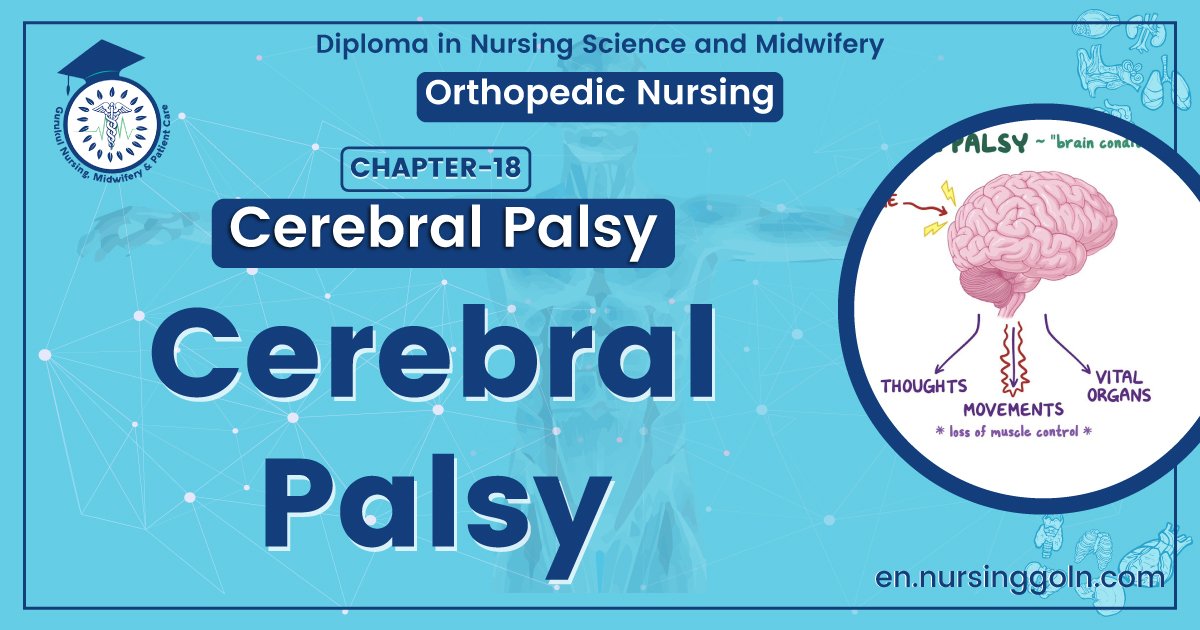Cerebral Palsy – An orthopedic nurse is a nurse who specializes in treating patients with bone, limb, or musculoskeletal disorders. Nonetheless, because orthopedics and trauma typically follow one another, head injuries and infected wounds are frequently treated by orthopedic nurses.
Ensuring that patients receive the proper pre-and post-operative care following surgery is the responsibility of an orthopedic nurse. They play a critical role in the effort to return patients to baseline before admission. Early detection of complications following surgery, including sepsis, compartment syndrome, and site infections, falls under the purview of orthopedic nurses.
Cerebral Palsy
Definition of cerebral palsy:
The term ‘cerebral palsy’ includes a group of disorders that results from non-progressive brain damage during early development and are characterized by abnormalities of movement and posture.
[Ref- Apley’s, “System of orthopedics and fractures”, 9h edition, P-235]
Or
Cerebral palsy’ is a group of non-progressive disorder resulting from malformations of the motor centers and pathways of brain.
[Ref- Parul Datta, 2nd edition, page 400]
Or
Cerebral palsy refers to a group of disorders that result from a non-progressive abnormality within the brain that develops before, during or shortly after birth.

Causes of cerebral palsy:
Cerebral palsy occur due to multiple risk factors. They are:
1. Prenatal factors:
- Cerebral ogenesis.
- Maternal infection. E.g: Rubella, Toxoplasmosis.
- Maternal disease. E.g: Gestational DM, HTN.
2. Natal factors/ cause:
- Birth asphyxia.
- Birth injury.
- LBW( low birth weight).
- Prematurity/Premature birth.
- Prolong labour.
3. Post natal factors:
- Hypoglycaemia
- Brain injury/ Head injury
- Kernicterus
- Meningitis
- Encephalitis
- Subdural haemorrhage
- Acid base imbalance
- Hyperpyrexia
- Severe haemorrhage
[Ref- Apley’s, “System of orthopedics and fractures”, 9″” edition, P-236+ Parul Datta 2 edition, page 399]
Classification of cerebral palsy:
Cerebral palsy is usually classified according to the type of motor disorder. These are given below:
1. Spasticity / Spastic cerebral palsy( About 65%): It is the commonest muscle movement disorder and is associated with damage to the pyramidal system in the CNS. It is characterized by increased muscle tone and hyper-reflexia. The resistance to passive movement may obscure a basic weakness of the affected muscles.
2. Athetosis( About 30%): It manifests as continuous, involuntary, writing movements which may be exacerbated when the child is frightened. It is caused by damage to the extrapyramidal systems of the CNS. In pure athetoid cerebral palsy, joint contractures are unusual and muscle tone is not increased
3. Ataxia: It appears in the form of muscular in-coordination during voluntary movements. It is usually due to cerebellar damage. Balance is poor and the patient walks with a characteristic wide based gait.
4. Hypotonia: It is usually a phase, lasting several years during early childhood before the features of
spasticity become obvious.
5. Dystonia: It may occur with athetosis. There is a more generalized increase in muscle tone and abnormal positions include by activity.
6. Mixed palsy: It appears as a combination of spasticity and athetosis. The presences of both types of motor disorder can make the results of surgical intervention unpredictable.
According to the anatomical site:
1. Monoplegia: It occasionally appears in an upper limb; careful examination will often show that other areas are involved as well. True monoplegia is so unusual that other diagnoses should be considered, e.g. a neonatal brachial plexopathy
2. Hemiplegia: It is the commonest cerebral disorder. This usually appears as a spastic palsy on one side of the body with the upper limb more severally affected than the lower. Most of these children can walk and they respond reasonably well to treatment.
3. Diplegia: It involves both side of the body, with the lower limbs always most severely affected.
4. Total body involvement: It describes a general and often more severe disorder affecting all four limbs, the trunk, neck and face with varying degrees of severity. Patients usually have a low IQ, they may have epilepsy, they are often unable to walk and the response to treatment is poor
According to the severity:
1. Mild cerebral palsy(20%): Pts impaired ambulatory fine movements.
2. Moderate cerebral palsy(50%): Impaired gross motor, fine motor.
3. Severe cerebral palsy (30%): Multiple defects and unable to perform usual activities.
[Ref- Apley’s, “System of orthopedics and fractures”, ” edition, P-235,236 + Parul Datta 2 edition, page 399]
Clinical feature of cerebral palsy:
1. History: The patient has – History of
i. Prenatal toxemia,
ii. Haemorrhage,
iii. Premature birth,
iv. Difficult labour,
v. Foetal distress or kernicterus should arouse suspicion
2. Early manifestation:
i. Asymmetric movement
il. Feeding difficulties
iii. Poor sucking
iv. Excessive high pitch/feble cry
v. Poor head control
3. Late manifestation:
i. Restricted voluntary movements
ii. Delayed gross motor development
iii. Abnormal posture
iv. Incontinence of stool
v. Delayed or defective speech
vi. Mental retardation
vii. Convulsion.
viii. Pseudobulbar palsy
ix. Hardings drying muscle.
Or
There are several different types of cerebral palsy. Some people have a mixture of symptoms.
A) Symptoms of spastic cerebral palsy, the most common type, include:
- Muscles that are very tight and do not stretch. They may tighten up even more over time.
- Abnormal walk (gait): arms tucked in toward the sides, knees crossed or touching, legs make “scissors” movements, walk on the toes.
- Joints are tight and do not open up all the way (called joint contracture).
- Muscle weakness or loss of movement in a group of muscles (paralysis).
- The symptoms may affect one arm or leg, one side of the body, both legs, or both arms and legs.
B) The following symptoms may occur in other types of cerebral palsy:
- Abnormal movements (twisting, jerking, or writhing) of the hands, feet, arms, or legs while awake, which gets worse during periods of stress.
- Tremors.
- Unsteady gait.
- Loss of coordination.
- Floppy muscles, especially at rest, and joints that move around too much.
C) Other brain and nervous system symptoms:
- Decreased intelligence or learning disabilities are common, but intelligence can be normal.
- Speech problems (dysarthria).
- Hearing or vision problems.
- Seizures.
- Pain, especially in adults (can be difficult to manage).
D) Eating and digestion symptoms:
- Difficulty sucking or feeding in infants, or chewing and swallowing in older children and adults.
- Problems swallowing (at all ages).
- Vomiting or constipation.
E) Other symptoms:
- Increased drooling.
- Slower than normal growth.
- Irregular breathing.
- Urinary incontinence.
The diagnostic evaluation of cerebral palsy:
Details history related to the condition is most important for diagnosis. These should include history prenatal and perinatal period including apgar score, resuscitation, birth injury etc. history of neonatal period with physical, neurological and developmental assessment are significant diagnostic evidence. Language development, personal development, personal social behavior and learning disability should be examined along with gross motorand fine motor development.

Special diagnostic evaluation should include:
1. CT Scan.
2. MRL
3. EEG.
4. Psychometry test.
5. Psychosocial and emotional handicaps of the child.
[Ref-Purul Datta 2 edition, page 400]

Management of cerebral palsy:
A) General management:
1. Physiotherapy:
- Assist in exercise during.
- Passive.
- Encourage games.
- Warm birth, hydrotherapy.
- Good poster during walking, sitting.
2. Speech therapy.
3. Hearing aid.
4. Educational support.
5. Special school:
- Day care centre.
- Residential care.
B) Drug therapy: Drug therapy is indicated in symptomatic management of child with CP. The common used drug are:
1. Spasticity Diazepam
2. Athetosis- Levodopa
3. Hypotonia-Strychnine
4. Dystonia- Carbamazepine
5. Convulsion-phenobarbitone
6. Pain-Analgesics.
C) Operative management: Surgical management may be needed for bony deformities and stabilizing the joints or releaving the contracture.
1. In the upper limb: Arthodesis of wrist-correction of flexion deformity,
2. In the lower limb: Flexion deformity of knee Eggers operation.
3. Foot deformity:
- Open elongation
- Osteotomy of calcaneum.
D) Occupational therapy: Occupational therapy can be arranged as some simple occupation (typing) so that when they grow up, they can earn something for their own. Positive application of certain repetitive movements of legs, hands and fingers can used during occupational training which also help to relax the spastic muscles. The child should be trained in self care like feeding, dressing, bathing, brushing etc.
[Ref- Parul Datta 2 edition, page 400]
Possible complications may arise from cerebral palsy:
1. Bone thinning or osteoporosis.
2. Bowel obstruction.
3. Hip dislocation and arthritis in the hip joint.
4. Injuries from falls.
5. Joint contractures.
6. Pneumonia caused by choking.
7. Poor nutrition.
8. Reduced communication skills (sometimes).
9. Reduced intellect (sometimes).
10. Scoliosis.
11. Seizures (in about half of patients).
12. Social stigma.

Nursing Management cerebral palsy:
A. Nursing assessment: Nursing assessment should include:
1. The detection of ability to perform activities of daily living( ADL)
2. Developmental milestones
3. Neurological reflexes, feeding behavior, nutritional status, bladder and bowel habits, problem related to vision, hearing and language. 4. Associated health hazards or congenital anomalies,
5. Present problems, present child interactions, treatment compliance etc.
B. Nursing intervention: nursing care of the child with cerebral palsy should include specialized care in the following aspects along with routine care of a child.
1. Increasing mobility and minimizing deformity: These should be achieved by:
- Encouraging exercise as directed by physical therapist,
- Use of splints or brace to facilitate muscle control, motivation for practicing self care and arranging specially prepared self care articles( long handed spoon, sponge handle toothbrush etc),
- Play materials to be provided for improvement of co-ordinate movement. • Good body alignment to be maintained to prevent contractures.
2. Maximizing growth and development:
- Planning daily care with special approach for feeding, sleeping, toileting, play, physical therapy, special interest of the child, safety measures and emotional needs according to the level of the childs ‘disability.
- Allowing independence and self help with comfortable environment (both physical and emotional) and educational opportunities by special schooling or arrangeing special training.
- Strengthening family process by encouraging to express feeling, frustrations and need for help for continuation of care of the child.
3. Protecting the child from physical injury and providing security by good patient child relationship and family support.
4. Teaching the parents and family members about home based care and continuation of treatment with regular follow up. Information to be given about the available facilities for specialized care of the children with CP.( e.g. spastic society, institution for cerebral palsy or handicapped children) Parents also need guidance from social workers er community health nurse regarding the continued care and management of these children.
[Ref-Parul Datta 2nd edition, page 400]
Read more:
